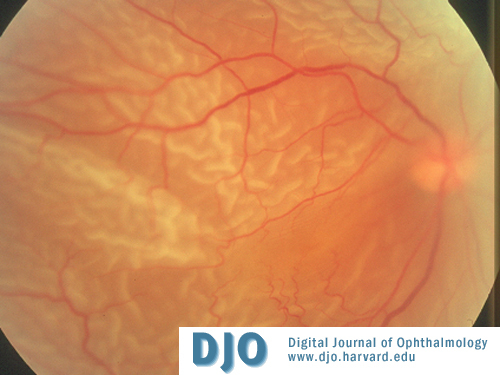47 year old female with history of flashes of light OD
Digital Journal of Ophthalmology 2005
Volume 11, Number 6
January 9, 2005
Volume 11, Number 6
January 9, 2005
Pupils - surgically dilated OD pupil, unable to determine if there is an afferent defect.
Intraocular pressures: 8 mm Hg OD, 18 mm Hg OS
Lens - aphakic
Dilated fundoscopic examination:
Silicone oil with total retinal detachment with multiple breaks, retinal and submacular fibrosis (Figures 1 and 2).

Fundus Picture 1
Initial fundus examination
Initial fundus examination

Fundus pic 2
Initial peripheral fundus exam
Initial peripheral fundus exam
Initial exam.
Requires Windows Media Player to view.
Requires Windows Media Player to view.
Membrane removal.
Retinotomy.
Endolaser.
Final appearance.
Visual outcome in PVR has been historically poor after repair. Many studies such as the Silicone Oil Study group have reported 11-25% of patients overall will have 20/100 or better vision (8,9). It is hypothesized that poor visual outcome after PVR repair may be due to irreversible photoreceptor loss or misaligment, epiretinal and subretinal pathology such as RPE scarring and multilayering, toxicity to intraocular agents such as silicone oil, or optic neuropathy (3).
The current management of PVR is largely surgical. The Silicone Oil Study group evaluated the outcomes of vitreoretinal surgery for retinal detachment with PVR and compared long-acting gas or silicone oil as the intraocular tamponade. In this prospective, randomized, multicentered surgical trial, it was found that silicone oil and perfluoropropane gas were equal in most respects for the management of retinal detachments with PVR (8).
Many studies have investigated the use of adjuvant therapies for fighting PVR. These agents have typically targeted the proliferation of cell types known to be involved in PVR, the production and subsequent traction of the extracellular matrix proteins, retinal deposition of fibrin for the scaffolding of membrane formation, or growth factors found in PVR development. One of the first agents used was Daunorubicin infused at the time of vitrectomy. This randomized study found a significant decrease in reoperations after one year of treatment. However, retinal reattachment rates were only marginally improved, and there was no statistically significant difference in visual acuity between the two groups (10).
Current trials in Europe have examined 5-flourouracial (5-FU) and low molecular weight heparin (LMWH) in combination to reduce PVR formation. These studies showed significant reduction in both the incidence of postoperative PVR and in the re-operation rate. Again, visual outcomes in this study were not statistically different between adjuvant and placebo groups (11). Other promising agents currently under investigation include intravitreal injections of corticosteriods and retinoic acid (12,13).
2. The Retina Society Terminology Committee. The classification of retinal detachment with proliferative vitreoretinopathy. Ophthalmology 1983; 90: 121-125.
3. Cardillo JA. Stout JT. LaBree L. Azen SP. Omphroy L. Cui JZ. Kimura H. Hinton DR. Ryan SJ. Post-traumatic proliferative vitreoretinopathy. The epidemiologic profile, onset, risk factors, and visual outcome. Ophthalmology 1997; 104(7):1166-73.
4. Claes C, Bartz-Schmidt K, Eckardt C. Advanced Vitreoretinal Course, Antwerp, Belgium Mar. 16-8 2001.
5. Kon CH. Asaria RH. Occleston NL. Khaw PT. Aylward GW. Risk factors for proliferative vitreoretinopathy after primary vitrectomy: a prospective study. British Journal of Ophthalmology. 2000; 84(5):506-1.
6. Bonnet M. Guenoun S. Surgical risk factors for severe postoperative proliferative vitreoretinopathy (PVR) in retinal detachment with grade B PVR. Graefes Archive for Clinical & Experimental Ophthalmology. 1995; 233(12):789-91.
7. Nagasaki H. Shinagawa K. Mochizuki M. Risk factors for proliferative vitreoretinopathy. Progress in Retinal & Eye Research. 1998; 17(1):77-98.
8. Abrams GW. Azen SP. McCuen BW 2nd. Flynn HW Jr. Lai MY. Ryan SJ. Vitrectomy with silicone oil or long-acting gas in eyes with severe proliferative vitreoretinopathy: results of additional and long-term follow-up. Silicone Study report 11. Archives of Ophthalmology. 1997; 115(3):335-44.
9, Lewis H, Aaberg TM, Abrams GW. Cause of failure after initial vitreoretinal surgery for severe proliferative vitreoretinopathy. Am J Ophthalmol 1991; 111: 8-14.
10. Wiedemann P. Hilgers RD. Bauer P. Heimann K. Adjunctive daunorubicin in the treatment of proliferative vitreoretinopathy: results of a multicenter clinical trial. Daunomycin Study Group. American Journal of Ophthalmology. Oct; 126(4):550-9.
11. Asaria RH. Kon CH. Bunce C. Charteris DG. Wong D. Khaw PT. Aylward GW. Adjuvant 5-fluorouracil and heparin prevents proliferative vitreoretinopathy : Results from a randomized, double-blind, controlled clinical trial. Ophthalmology. 2001. 108(7):1179-83.
12. Jonas JB. Hayler JK. Panda-Jonas S. Intravitreal injection of crystalline cortisone as adjunctive treatment of proliferative vitreoretinopathy. British Journal of Ophthalmology. 2000; 84(9):1064-7.
13. Takahashi M. Refojo MF. Nakagawa M. Veloso A Jr. Leong FL. Antiproliferative effect of retinoic acid in 1% sodium hyaluronate in an animal model of PVR. Current Eye Research. 1997; 16(7):703-9.